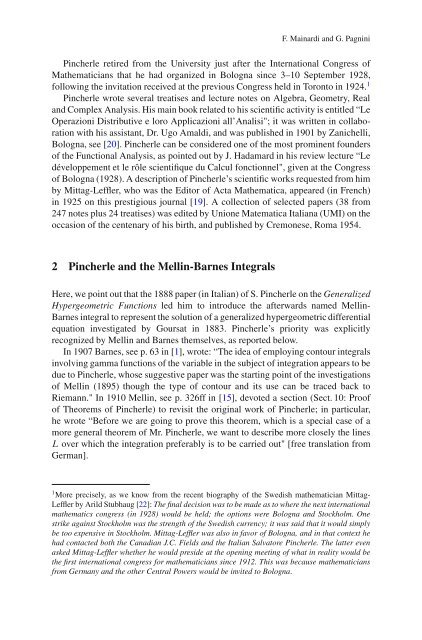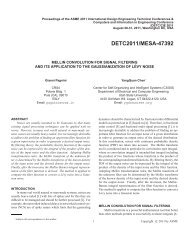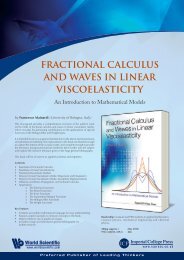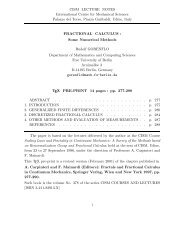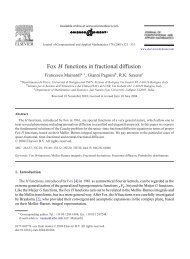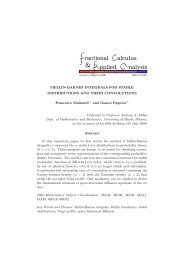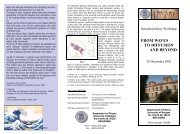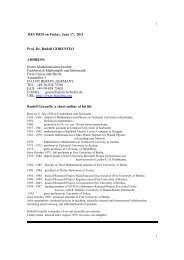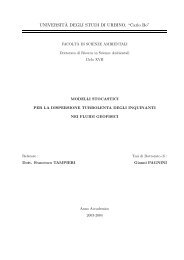The Role of Salvatore Pincherle in the Development of Fractional ...
The Role of Salvatore Pincherle in the Development of Fractional ...
The Role of Salvatore Pincherle in the Development of Fractional ...
Create successful ePaper yourself
Turn your PDF publications into a flip-book with our unique Google optimized e-Paper software.
F. Ma<strong>in</strong>ardi and G. Pagn<strong>in</strong>i<br />
<strong>P<strong>in</strong>cherle</strong> retired from <strong>the</strong> University just after <strong>the</strong> International Congress <strong>of</strong><br />
Ma<strong>the</strong>maticians that he had organized <strong>in</strong> Bologna s<strong>in</strong>ce 3–10 September 1928,<br />
follow<strong>in</strong>g <strong>the</strong> <strong>in</strong>vitation received at <strong>the</strong> previous Congress held <strong>in</strong> Toronto <strong>in</strong> 1924. 1<br />
<strong>P<strong>in</strong>cherle</strong> wrote several treatises and lecture notes on Algebra, Geometry, Real<br />
and Complex Analysis. His ma<strong>in</strong> book related to his scientific activity is entitled “Le<br />
Operazioni Distributive e loro Applicazioni all’Analisi"; it was written <strong>in</strong> collaboration<br />
with his assistant, Dr. Ugo Amaldi, and was published <strong>in</strong> 1901 by Zanichelli,<br />
Bologna, see [20]. <strong>P<strong>in</strong>cherle</strong> can be considered one <strong>of</strong> <strong>the</strong> most prom<strong>in</strong>ent founders<br />
<strong>of</strong> <strong>the</strong> Functional Analysis, as po<strong>in</strong>ted out by J. Hadamard <strong>in</strong> his review lecture “Le<br />
développement et le rôle scientifique du Calcul fonctionnel", given at <strong>the</strong> Congress<br />
<strong>of</strong> Bologna (1928). A description <strong>of</strong> <strong>P<strong>in</strong>cherle</strong>’s scientific works requested from him<br />
by Mittag-Leffler, who was <strong>the</strong> Editor <strong>of</strong> Acta Ma<strong>the</strong>matica, appeared (<strong>in</strong> French)<br />
<strong>in</strong> 1925 on this prestigious journal [19]. A collection <strong>of</strong> selected papers (38 from<br />
247 notes plus 24 treatises) was edited by Unione Matematica Italiana (UMI) on <strong>the</strong><br />
occasion <strong>of</strong> <strong>the</strong> centenary <strong>of</strong> his birth, and published by Cremonese, Roma 1954.<br />
2 <strong>P<strong>in</strong>cherle</strong> and <strong>the</strong> Mell<strong>in</strong>-Barnes Integrals<br />
Here, we po<strong>in</strong>t out that <strong>the</strong> 1888 paper (<strong>in</strong> Italian) <strong>of</strong> S. <strong>P<strong>in</strong>cherle</strong> on <strong>the</strong> Generalized<br />
Hypergeometric Functions led him to <strong>in</strong>troduce <strong>the</strong> afterwards named Mell<strong>in</strong>-<br />
Barnes <strong>in</strong>tegral to represent <strong>the</strong> solution <strong>of</strong> a generalized hypergeometric differential<br />
equation <strong>in</strong>vestigated by Goursat <strong>in</strong> 1883. <strong>P<strong>in</strong>cherle</strong>’s priority was explicitly<br />
recognized by Mell<strong>in</strong> and Barnes <strong>the</strong>mselves, as reported below.<br />
In 1907 Barnes, see p. 63 <strong>in</strong> [1], wrote: “<strong>The</strong> idea <strong>of</strong> employ<strong>in</strong>g contour <strong>in</strong>tegrals<br />
<strong>in</strong>volv<strong>in</strong>g gamma functions <strong>of</strong> <strong>the</strong> variable <strong>in</strong> <strong>the</strong> subject <strong>of</strong> <strong>in</strong>tegration appears to be<br />
due to <strong>P<strong>in</strong>cherle</strong>, whose suggestive paper was <strong>the</strong> start<strong>in</strong>g po<strong>in</strong>t <strong>of</strong> <strong>the</strong> <strong>in</strong>vestigations<br />
<strong>of</strong> Mell<strong>in</strong> (1895) though <strong>the</strong> type <strong>of</strong> contour and its use can be traced back to<br />
Riemann." In 1910 Mell<strong>in</strong>, see p. 326ff <strong>in</strong> [15], devoted a section (Sect. 10: Pro<strong>of</strong><br />
<strong>of</strong> <strong>The</strong>orems <strong>of</strong> <strong>P<strong>in</strong>cherle</strong>) to revisit <strong>the</strong> orig<strong>in</strong>al work <strong>of</strong> <strong>P<strong>in</strong>cherle</strong>; <strong>in</strong> particular,<br />
he wrote “Before we are go<strong>in</strong>g to prove this <strong>the</strong>orem, which is a special case <strong>of</strong> a<br />
more general <strong>the</strong>orem <strong>of</strong> Mr. <strong>P<strong>in</strong>cherle</strong>, we want to describe more closely <strong>the</strong> l<strong>in</strong>es<br />
L over which <strong>the</strong> <strong>in</strong>tegration preferably is to be carried out" [free translation from<br />
German].<br />
1 More precisely, as we know from <strong>the</strong> recent biography <strong>of</strong> <strong>the</strong> Swedish ma<strong>the</strong>matician Mittag-<br />
Leffler by Arild Stubhaug [22]: <strong>The</strong> f<strong>in</strong>al decision was to be made as to where <strong>the</strong> next <strong>in</strong>ternational<br />
ma<strong>the</strong>matics congress (<strong>in</strong> 1928) would be held; <strong>the</strong> options were Bologna and Stockholm. One<br />
strike aga<strong>in</strong>st Stockholm was <strong>the</strong> strength <strong>of</strong> <strong>the</strong> Swedish currency; it was said that it would simply<br />
be too expensive <strong>in</strong> Stockholm. Mittag-Leffler was also <strong>in</strong> favor <strong>of</strong> Bologna, and <strong>in</strong> that context he<br />
had contacted both <strong>the</strong> Canadian J.C. Fields and <strong>the</strong> Italian <strong>Salvatore</strong> <strong>P<strong>in</strong>cherle</strong>. <strong>The</strong> latter even<br />
asked Mittag-Leffler whe<strong>the</strong>r he would preside at <strong>the</strong> open<strong>in</strong>g meet<strong>in</strong>g <strong>of</strong> what <strong>in</strong> reality would be<br />
<strong>the</strong> first <strong>in</strong>ternational congress for ma<strong>the</strong>maticians s<strong>in</strong>ce 1912. This was because ma<strong>the</strong>maticians<br />
from Germany and <strong>the</strong> o<strong>the</strong>r Central Powers would be <strong>in</strong>vited to Bologna.


